#tumeric dye
Note
What color did you like before?
4 years old: Blue and purple, but ONLY when tye-dye mixed together
6 years old: Hot pink fuschia. With glitter
8 years old: Purple.
12 years old: Green and blue.
17-19: Migraine Emo Era. All clothes were black or grey. Disliked bright colours. Kept the lights off. Somewhat fond of blue.
20: Orange, gold, silver, and lime.
22-26: Tumeric yellow, orange-red
27: Indian yellow, Caramel, PEI dirt red, warm beige, red clay, brown, rusty orange,
830 notes
·
View notes
Text


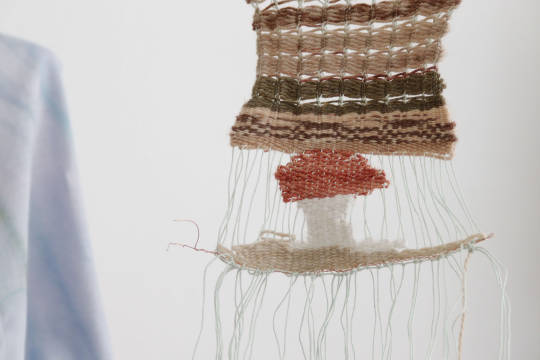
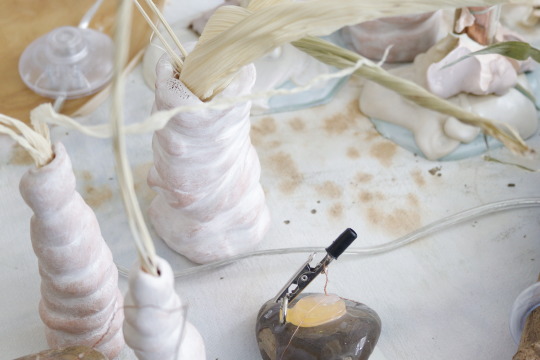
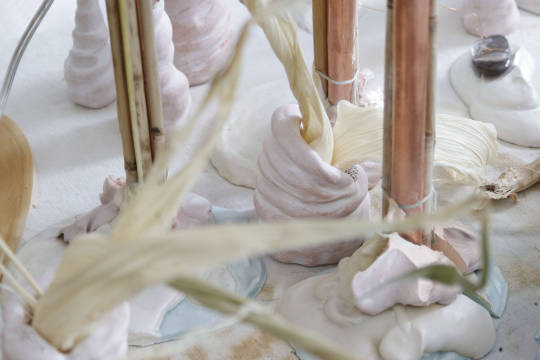
Kleiner Schnipsel von langen Tagen.
…
D. Sidefact: Ich liebe. Und was tust Du so?
Neulich Nacht in eine andere Form von Rausch verstrickt, wurden mein Körper und darin stattfindende Emotionsströme, bereits seit einigen Stunden konfettiartig dezentralisiert. Durch die schwarze Schönheit der Psychoanalyse wieder zusammengefegt: „Entwicklung entsteht nur durch Krise“. Hätte ich in dieser Nacht meinen Stachel oder gar ein Ein-Horn gehabt, Digger, ich hätte ihn Dir alles bis zum Kater ausgeliehen. Schmerzpunkte durch Nadeln bearbeiten ist bekanntermaßen die Pflege der Lebensenergien des Körpers, so die traditionell chinesische Heilkunde. Ich frage mich, wo meine Emotionen sitzen und ob ich diese auch nadeln könnte. Alles für die Krise sozusagen. Was bedeutet es irgendwie Mitte 30 geworden zu sein? Schaue ich auf Joan und Erik Erikson’s Stufenmodel frage ich mich unwillkürlich in welcher Individualkrise mein Umfeld und ich wohl stecken mögen – so ganz hoch offiziell. Wir sind wohl nicht mehr die Gruppe „frühes Erwachsenenalter“, aber lese ich „Intimität und Solidarität vs. Isolation“, „Wir sind, was wir lieben“, soll heißen in diesem Lebensabschnitt bearbeiten wir das Lieben, beginne ich zu zweifeln an der Vorstellung erwachsen zu sein. Schaffen wir es Dich und Mich als zweisam und zugleich einsam anzuerkennen und nicht liebestrunken im „me, myself and I“ verloren zu gehen, treten wir aus der Krise als – nennen wir es – „beziehungsfähig“ hervor. Meine Küchentisch-Forensik lässt nur einen Schluss zu: Ist die Krise zunächst, entgegen unserem allgemeinen Verständnis, weder negativ noch positiv, also nach den Grundregeln des Ökosystems einfach nur mal Störung, können wir sie als ein Thema, ein zu bearbeitendes Feld, das sich mir stellt, angehen. Dann werden wir und ich durch geschicktes Krisenmanagment entweder das nächste Level passieren oder doch noch viele Extra-Runden drehen müssen; wie wenn Super Mario einfach nicht mehr springen mag, wird meine Generation die Krise des Lieben Lernens verpasst haben oder nicht leben wollen. Das Level scheint einen Systemfehler zu haben. Soll heißen, vielleicht müssen wir noch in anderen Krisenzuständen nachsitzen, vielleicht war unsere Comfort Zone einfach zu nice. Ergebnis ist ne Menge Salat. Denn wir hängen zwischen den Krisen: Das Lieben fällt uns auf die Füße und das Erlernen der Fürsorge, der Generativität saust uns um die Ohren. „Ich bin, was ich bereit bin zu geben.“, so wohl die altersentsprechende Herausforderung. Cheerio, lasst uns Krise lieben. Oder: die Psychoanalyse verwerfen? Wir können entscheiden, ob wir Boutlismus verbreiten oder radikale Zärtlichkeiten (s. Şeyda Kurt) austauschen. Ich wünschte, ich würde an Einhörner glauben und die Revolution für das Leben (s. Eva von Redecker) wäre das Myzel der Zwischenräume.
#strasbourg#ceaac#filderstraße34#stuttgart#evavonredecker#ŞeydaKurt#linda weiß#unicorn#sugar#dyeing#tumeric
1 note
·
View note
Note
what do you recommend for dying with beets? Use raw fiber, batts or already spun yarns? Cotton or wool? Do I have to shred up the beets or can I use the juice in the can and eat the beets myself ? Does it smell like beets? Use color fixer or something more natural? Dyou tbink I can like speckle it on an already commercially dyed pink yarn for pops of darker pink? or dip dye it for pink gradients?
Tbh I would recommend absolutely none of this, for the sole reason that beets, like red cabbage and tumeric, do not produce lasting dyes. The colors you get from them don't want to stick to things and even if you do manage to transfer color from the dyebath to your fiber, it will come out pretty quickly (within months at best) and usually the end result is something that kind of just looks stained.
To attempt to answer most of your questions though (which are very good questions, but would be answered with an unequivocal No if you're asking them about beets specifically):
I personally prefer dyeing things as washed fleece (not raw--you need to remove the dirt and lanolin or no dye will stick). It feels safest to me and I enjoy the extra freedom it gives over dyeing as yarn--with dyed fleece I can alter the color just by mixing other things in as I card it, or I can pull out the most vibrantly dyed sections and process them separately for different effects, etc. But it's entirely personal preference, and you can dye either yarn or fiber using natural materials without much difference.
I would not recommend dyeing batts using any traditional dyeing methods (except perhaps solar dyeing, which is very gentle), as the likelihood that you come out of it with a batt that's still spinnable, at least without reprocessing, is definitely lower than with fleece. I have heard of people dyeing batts by cooking them in a tray of dyebath in the oven, but I've never tried it and can't speak to how well it works. Batts should be alright with acid dyes, but natural dyes are (for the most part) not instant and require more time, heat, exposure, etc.
Wool is much easier to dye than cotton. I would always recommend testing new dyeing ideas on wool rather than a plant based fiber if possible.
Dicing or grating the dye material is not strictly necessary but is a good idea for larger or less permeable materials--for example, I don't bother shredding avocado peels because they just don't need it as they're very thin. But I do always chop avocado pits into small pieces, because cooking whole avocado pits is not very energy efficient, and possibly would not get all the dye out.
I definitely would not recommend trying to dye things using cans of food (especially the juice or canning water from said foods). You will get better, more vibrant color with fresh dye materials than with dried or frozen dye materials, and I have to imagine that extends to canned goods as well. Generally you also want to use both the juice and the fruit/vegetable/whatever, as you'll get a lot more color that way. I suppose if you were only dyeing a tiny amount of fiber, just using, say, blueberry juice and keeping the blueberries to continue cooking into jam, you'd be fine. Same if you had tons of blueberries and could easily amass large amounts of blueberry juice. But a definite limiting factor in natural dyeing is the amount of dye material that you can get your hands on, so people usually use all of that material instead of trying to reserve parts of it for eating.
I have never found that the smell of the dye material transfers to wool when it's dyed. Once it's dry it just smells like wool. Not necessarily the case with plant fibers, but I would generally not worry about making your wool smell like food permanently.
I don't know what color fixer is (the only thing with that exact name that came up was a laundry detergent for colored clothes that may have fugitive dyes--definitely do not use this in the place of a mordant), but the majority of natural dyes need things called mordants to adhere the color to the material. The more natural types of mordants are minerals (copper and iron are very commonly used) or tannins (such as from soaking acorns or from walnut hulls). Unless you are using a dye material that doesn't need a mordant (indigo and woad, for example, are well known for not needing mordants--although you also can't just throw them in a pot with water and simmer for a while to extract the dye from them, it's more involved than that. So there are trade offs), you will always need to mordant your fiber to get a good and long lasting color. For example, if you want to dye some wool with yellow onion skins and you don't mordant the wool, you will still end up with dyed wool. But it's a very light wheat color. If you want rich colors, you need to use a mordant.
Natural dyes are not suited for speckling yarns. Acid dyes work great for that, but natural dyes usually require you to fully immerse the fiber in the dyebath, and then expose it to heat over a long period of time. I do know that you can get speckled yarns using resist dyeing methods--essentially, if you take a skein of yellow yarn and tie sections of it very tightly and then dye it all in a red dyebath, you would get a primarily red (or reddish orange, perhaps) yarn with yellow speckles wherever those ties were. So that is one method that you could use to get a speckled yarn with natural dyes. But the method you're suggesting (just speckling it with a paintbrush or your hands for pops of different colors) is not suited to natural dyes. The most likely outcome of that would be no obvious change whatsoever. The second most likely outcome is probably just yarn with intermittent and random stains.
Natural dyes are not suited to dip dyeing, either. I think you could potentially get it to work, or at least get similar effects--you could mordant a piece of fabric/hank of yarn and then cook it in the dyebath like normal except leave part of it sitting next to and above the pot, which would then remain undyed. But whether the yarn would felt or get weird or whether there would be any unforeseen complications, that I don't know. It sounds like a good thing to experiment with once you already have some foundational knowledge of natural dyeing. But I wouldn't recommend it as a first project, for sure.
It sounds like the parts of dyeing that you have an interest in are better suited to acid dyes, so that might be a better route for you to go down ! If you do want to try natural dyes, I would recommend starting out with some good beginner dye materials, such as onion skins (by far the easiest and least bad-smelling dye material I've ever used, this would be my firm recommendation). Another good option would be powdered madder or other powdered dye materials (I specifically say madder, though, because it yields beet reds) that can be done without much fuss.
I hope this was helpful !
#i assume (possibly incorrectly) that was prompted by the comment i made in the tags#about dyeing some yarn with beets for my sweater. but that was like... not actually something i was considering#and more a joke to get 'beet colored yarn' that is not the color of beets but is color FROM beets#which would not be good color. hence the joke#i learnt my lesson about dyeing things with beets as a kid bc the one year my family got tasked with making#the pascha eggs for our church my mom dyed them with beets and guess what happened ?#they were sort of a weird off brown and the color came off every time you touched it and then stained the hands#it doesn't work and shouldnt be tried on anything that you care about or need to get good results with#by all means if youre determined to get good lasting color out of beets give it a few shots#but try it with scrap and in small amounts so that you dont waste the stuff that is almost certainly about to be ruined#by beets.#i do love beets but they dyeing is not among their many uses#natural dye#natural dyeing
97 notes
·
View notes
Text


End result of tumeric dye ^__^ such a happy yellow
#EXTREMELY happy with this.. I wanted orange but this is honestly way better#I’ll find another way to do orange ^__^
11 notes
·
View notes
Text
Michael Wilkinson is killin’ it.
General thoughts and a few notes on costumes design so far. Episodes 1-5.
thus far, the costuming department seems to take some notes from Rogue One as its predecessor with utilitarian, lived in garments. For example, Jyn’s pants were designed, with vest sliders and webbing details, enough bulk to allow both Felicity, and her stunt double, room to wear knee pads. Along the same lines, Cassian’s initial look which is the costume that went on display as part of the promotional run for Andor, features a few note worthy motorcycle detailing in the knees, presumably for the same reason. Other similarities in costuming:
the breathing apparatus that both Maarva and Clem have on Kenari mirror the same one seen, as decoration, around Jyn’s neck in the Eadu scenes. (Prior to her climbing the platform.)
Practically speaking, as a prop, it is the same breathing mask and tube, dyed the same color.
fingerless gloves on the ladies
Cassian’s color palette is very similar.
Kyber crystals.
Although, from my recollection, Jyn’s is a piece of acrylic where it seems that the crystals used on Andor are genuine. Which I do appreciate as as much as I love both the design and meaning to Jyn’s crystals it often looks visually flat. The Sky Kyber catches light much prettier.
I’m not particularly knowledgeable of crystals, only vaguely aware of some from my stint in jewelry craftsmanship, so this is all spoken with a grain of salt. On my third watch, the one that Maarva has in the ship looks more like a man made Citrine which is heat-treated Amethyst, which is an Amethyst that is mined in Bolivia.
The overall color palette on Ferrix is yellow, specifically a mustard sort of yellow. I can’t help but wonder if this is to note that at least in our world, a natural yellow dye is easy to obtain. It can be obtained from a variety of sources including onion skins, tumeric, cold tea and rhubarb.
I can’t help but imagine some sort of community dye job to make all the various guild costumes thus the sense of cohesion in all the colors. And that would function so very well as it would be too expensive for anyone to be able to afford anything body the very limited color palette.
I love Bix’s base costume. It’s an integrated mix of athletic and performance fabrics that would wick sweat, and be comfortable to do her highly mobile job. The accented quilted inserts add shaping to her vest. Although, I find it strange in terms of function to have fingerless gloves while working on something heavy as she is. It is very much a design decision versus functionality and I am okay with it. (Again, not the first time there have been fingerless gloves recently.)
The colors are echoed over back in the Kenari flashbacks. All of the garments look as if they are uniforms from the adult figures that have been refitted smaller youth frames.
There are so many space hoodies in this show.
one on Ferrix.
Tamryn’s rough wool and or slub looking pull over.
Nemik’s.
The Aldhani Shepard “disguise”costumes as seen on our rebel cell are stunning. I also really like the base layers underneath all the sherpa, they look very coherent in terms of the color palette, fabric choices overall look. Lots of knits and textured fabrics to provide visual interest and warmth. Additionally, fingerless gloves again.
Cassian’s shirt that he picks up here and wears in episodes 4-5 is lovely. I love the black piping accents, the cross over front and tie on design at the right side. It looks to be a denim chambray fabric
Vel’s windbreaker looks like the base design is a gorka, as seen with the welted pockets, elasticated wrists. Presumably with the fabric base as well using something like a Gore-tex fabric. To me, it reads as another R1 nod, as a gorka is one of the options worn by the Pathfinders on Scarif. It’s also just a little gay to be wearing more army/military look. It’s one of the other pieces on Vel that gave off the initial lesbian five on episode 4 for me. Additionally, more than the blanket is shared, Vel and Cinta even share the poncho.
14 notes
·
View notes
Text
The various stages of the 212th discovering tumeric:
"Holy shit this soap makes me smell spicy! All the single Mandos love me now."
"Wait this shit dyes? Holy fuck it dyes our unit color!"
"It makes tea???? Tea that is good for you????"
"Wait hold up. You can just put it straight on food? Why didn't anyone tell me?!"
#/incoherent noises/#star wars the clone wars#212th attack battalion#source: we have 212th introjects reacting almost exactly like this at this very moment /lh
31 notes
·
View notes
Text
Herbal Remedies for Lichen Planus
Lichen planus is an autoimmune disease that affects the skin and mucus membranes. When the skin is affected, it results in itchy, red spots on the extremities. The following list of herbs can help soothe the itching, preventing potential scarring or infection from scratching.
Herbs should be finely ground and added to a carrier compound, such as coconut oil, vegetable oil, or unscented lotions without added dyes, and applied topically. Be aware that some people can be allergic to one or more of the following ingredients, so if you’re preparing something for someone else, be sure to inquire about their allergies.
[Agrimony herb] Agrimonia eupatoria
[Aloe Vera gel] Aloe barbadensis
[Bayberry bark] Morella cerifera
[Bigleaf Sagebrush leaf] Artemisia tridentata
[Bistort leaf] Polygonum spp.
[Blackberry/Raspberry leaf and root] Rubus spp.
[Black Tea steamed leaf] Camellia sinensis
[Blueberry/Bilberry leaf and fruit] Vaccinium spp.
[Calendula flower] Calendula officinalis
[Comfrey leaf] Symphytum officinale
[Creosote Bush herb] Larrea tridentata
Curcumin
[Ginger] Zingiber officinale rhizome
[Hawthorn leaf, flower, and fruit] Crataegus spp.
[Hollyhock leaf or root] Alcea rosea
[Hops] Humulus lupulus strobile
[Licorice root] Glycyrrhiza glabra
[Marshmallow leaf or root] Althaea officinalis
[Meadowsweet flowering top] Filipendula ulmaria
[Purslane leaf] Portulacca oleracea
[Thunder God Vine root] Tripterygium wilfordii
[Tormentil herb] Potentilla tormentilla herb
[Tumeric] Curcuma longa rhizome
[Yarrow flowering top] Achillea millefolium
#herbal magic#herbal remedies#herbs#witchcraft#green witch#witchy things#witchblr#book of shadows#grimoire#magic#beginner witch#green witchcraft#herbal properties#lichen planus
6 notes
·
View notes
Text
I have a lot of ideas boggling around in my head for stories involving original characters that I just haven’t bothered writing because nobody really cares about oc content unless it’s character x reader in which they can insert their oc.
But I’m just gonna dump this idea here to get it out of my head, its a bit witcher inspired in the sense that magical creatures are know but theyre at odds with the world of man due to the belief they cause blight and dismay, and it’s based in real world folklore and events too. My working title for it is Tumeric & the Weaver Hound and it’s a romance between a knight and a blind half elf named hound.
Hound was the result of an affair between a silk Weavers wife and a starlight elf who’re more closely related to a djinn than the faerie like elves.
His mother wasn’t a bad person, at least not at first, but she wasn’t a good one either. She married for money but it soon became apparent her husband was more focused on his trade and earning coin than he was with serving her every beck and call, and his frugal nature certainly didn’t sit right with her want for luxuries. And it was safe to say their marital bed saw little action beyond the frequent tossing and turning she’d do in an attempt to sleep through his snoring.
She’d soon start lamenting and complaining rather loudly to her friends in the market place about how miserable she was, how she was longing for a better man to just come and take her away even for a night to show her what she was missing out on, all the while blissfully unaware of an elf disguised as a man, all too eager to grant her her wish.
A wish that soon after leaves her pregnant. She tries to hide it at first, but soon lies to her husband that it was the result of one of their few nights of short lived relief. A lie she manages to keep up until hound is born that is. Pale, opal like ethereal skin, silver hair, pointy ears. Very much not human.
Her husband is obviously furious, but rather than admit wrong doing she doubles down saying that hound isn’t hers and is instead a changeling child, the arguing continues and with the threat of being divorced and left to fend for herself she grabs hound and holds him close to the fireplace to ‘scare’ the changelings true form out of him. (yes this is sadly a very real thing people used to do) And hound being only a baby is so fragile he’s left burned and blind.
A scuffle ensues, hounds father manages to get him free from her grasp without further hurting him and throws her out to the street calling the town guards on her while he’s at it.
He takes pity on the baby and decides to raise him as his own figuring he’d be of some use to him when he’s older, but being a magical creature he’d have to take care to keep him somewhat hidden. He names him hound because while he can’t see he developed a knack for sniffing out his bottle whenever it’d come close to feeding time, a skill that’d do him good in the future too.
As he got older his father tried teaching him how read and write to no success hoping he’d at least be able to do the books for his silk business. But he soon found his nimble fingers were very good for spinning thread, and he could tell which colours were which by the smells of the dye used for each silk. It wasn’t long before his father got the idea to try teaching him how to weave on a loom, he was skeptical at first but with his nose to guide where each thread was and maybe a bit of hidden magic, he soon learned how to make intricately designed cloths his father would sell as is or tailor to a customers wants.
Their two main customer bases of course being Nobles, and most importantly for our story, Knights. One of which has a tunic of whites, golds and yellows.
I haven’t got a name for him yet but I do know he’s the champion and personal bodyguard to the king, undefeated in the joust and contest between other knights of his court, and often the one sent out to do his bidding, usually collecting ‘taxes’ from problematic merchants or houses, but most importantly, investing possible sightings of magic folk when illness, plague, or blight rears its head.
Long story short, he ends up going to the silk weavers home on rumours that a magical creature hiding there had laid illness on the city, but upon searching the place despite his protests he finds hound hidden away in a small room weaving.
Hound immediately smells the tumeric used to colour the silk his clothes are comprised of and thinks he’s here to get fitted for his order like he’s done so many times before so not knowing he’s literally standing right in front of him he fumbles around looking for the fabric he made only to fall right into the knights arms and then fly into a panic and end up hurting himself because he had no clue there was another person in the room.
Anyway, might not make anything from this. Literally just an idea that won’t shut up in my brain that I thought y’all might like, honestly the idea came up because I harvested and processed my turmeric on Friday and my hands are still yellow ~Bambi
16 notes
·
View notes
Note
Dude. Did I see you at the grocery store with an entire pack of tumeric roots?? What do you need that many for???
I am reaching new heights of derangement.
and by that I mean Im doing meal prep for this week and need a lot of turmeric and I am also experimenting with some natural dyes.
-T
2 notes
·
View notes
Text
Figured I'd document my very niche process of bringing to life a sample of fabric from a seed to a coaster.
We grew a single cotton plant in the garden this year. We didn't even know if it would take. But we ended up getting 8 bolls from it! Two popped on the plant before we got frost, but the rest I was able to dry in the oven (175 degrees, after scoring the side, for about an hour) and harvest most of the fibers.
After getting the bolls open, processed the cotton by carefully picking the seeds out and carded it by hand (note: get actual carding brushes next time so my cotton isn't so rough spun). The real challenge was getting all the fibers straightened and aligned in the same direction without tools. I know better for next time.
Next, time to spin it on a drop spindel. This was challenging with the short fibers that weren't carded evenly, but I managed alright. I do need more practice at drop spinning. It's definitely a skill that I can say I'm in the "needs improvement" category for.
To color it, I made natural dye from black-eyed susans. But I lacked enough alum (which acts as a mordant, the part of the dye bath that helps the dye bind to the fibers in the fabric). So the result was a pale brown. I then went in with tumeric (with onion peels as the mordant this time), and I got a really saturated yellow/goldenrod color.
Finally, the last part was simple. I just knitted it into a square (phew!!). I only had enough from my bulbs first a small square, but it was great as a coaster.
It was definitely a lengthy process, but I really enjoyed it. Next year, I'll see if I can do a little more (and may flax/more natural dye plants!).
0 notes
Text
Studio Project 2 journal process
Ok so I have decided that I will make this post to serve as a journal for myself to write down my ideas in one place, but also be able to go back and see what I was thinking and my process as I go along but also after the project is completed. This way, you can also see how my ideas and thoughts have evolved. I am excited to document this like a journal so that I can have a way to analyze my own critical thinking skills and how they apply when being challenged creatively.
Tuesday 11/15:
Ok so I am struggling to figure out how I want to design my project. I decided I want to make this piece with some societal commentary like my artist does, while still incorporating my lighthearted and fun themes. I think I want to do women's reproductive rights. Or lack of. How we as a country are regressing when it comes to access to safe and effective healthcare as it applies to women's health. How our bodies have become politicized and are a divisive factor in our society. I know many people want to stay "neutral" on this topic, but to me, by staying neutral we cannot effectively elicit change. Women's healthcare has always lacked funding and research and for how far along we have made it in medical advancements, the lack of care given towards women is astonishing. This begins with a lack of proper sexual health education. Sex is not a bad thing. It is a very normal aspect of life and it is what creates life itself. This then leads into limiting access to birth control, which then leads to abortion. Our country had set a fair and balanced precedent on abortion access with the passing of Roe v Wade. However with the recent overturning of this landmark case, women's health seems to be regressing. With abortion access significantly limited, and even completely illegal in certain states (the states that need it the most to be honest), there has been some talk of birth control being limited. The first steps towards this has already been made with the supreme court ruling in the Burwell vs Hobby Lobby case, in which it was determined that private for profit corporations are able to deny birth control coverage to their employees. Therefore, I think it is important to talk about this.
Thursday 11/17
On Tuesday, I made a direct application uterus on silk chiffon. I am beading the ovaries, representing all the eggs we have. I also shifted my design idea. I am planning on doing the kalamkari traditional natural dyes process at home over the Thanksgiving break and I will use tumeric as my background color and add the additional elements after I have processed the main part of the fabric. For the design, I am planning on a fun, colorful planet (with swirls done by direct application). From this planet, a uterus (the one I made on Tuesday with the beading) is being beamed up by an alien spaceship, making the colorful planet shift to a cold, serious, barren place. The barren and cold will be depicted using the embroidered tree (it's back). This design is supposed to represent rights being taken away, thus causing a once fun planet to die. Still thinking about the presentation of the project, talked about a tent with Tina, but am still considering other shape ideas.
Friday 11/18
I decided to make the swirly planet using direct application. I think I will use the excess fabric that from the neon green dye I did in the previous flag project. I will then mix bright direct application colors to apply over the green and will leave some space for the green to show through. I am continuing to work on my embroidered tree.
Monday 11/21
I have ordered buffalo milk to my house in Houston and I will then go and try to collect the cow poop from a farm that is close to my neighborhood. I hope they say yes so I can begin processing my fabric for Kalamkari. The buffalo milk is coming on Wednesday.
Ok, so apparently I did not see that I have to meet a minimum of $69.99 to qualify for delivery, so I got an email saying that my order of buffalo milk is going to be cancelled. I looked up some alternatives and some websites are saying that goat milk works too, so I might try to get that at the store. I am emailing them so hopefully they can still help me out.
Tuesday 11/22
Today I got an email back saying they will do a specialty delivery for me since they are based in Austin, they require a minimum order for the drive to Houston to be worth it, but they did agree to deliver my order to my house. They also sent screen shots of their website that states the minimum delivery cost, so I really just missed that. I am glad they were able to accommodate me.
Around 5 pm, I will be going to the farm outside my neighborhood to see if I can get some cow poop.
I went to the farm and luckily there was a person there, and he gave me some poop. He gave me a lot, not sure how much I need because there are not any measurements, but I am planning to use all of it since the fabric is fairly large.

This is the farm!

These are the cows. I think it was their dinner time, they were all eating.

This is the poop. At first I was worried that there may not be any, but there was so much!!
The man was so nice considering I was asking for his cow's poop.
Wednesday 11/23
The buffalo milk has arrived and it came in reusable packing. So to keep the milk cold, they use insulated bags, but rather than creating further waste by manufacturing a bunch of these bags for customers to keep, they schedule packaging pick ups so they can then reuse their packing for another order, thus reducing waste. I think its great when companies do this because it is mass manufacturing done by corporations that cause the bulk of waste in our country, rather than individual consumption. It is great to see a company do this, as individual efforts result in very minimal change.

This is the bag that the buffalo milk came in! so fun, so cute.
Since all the materials have been gathered, I began the process this afternoon.

This is the cow poop. It was easily malleable and seemed to take to the water fairly easily, in that it was dissolving quickly. It also DID NOT SMELL.

In the chemical dye process, this is roughly equivalent to the soda ash soak solution that we place our fabric in before direct application so that the fabric is prepared for the dye. I think that the soda ash soak solution is significantly smellier than this cow poop mixture, as the cow poop mixture has no scent. However the soda ash soak smells like organic waste and immediately induces a gag reflex for me. Considering I was up close to the poop and actively mixing it, I would say that if there was a smell, I would have smelt it. But just opening the soda ash soak lid unleashes the pungent organic waste scent that is deeply disturbing and I do not even get that close to it.
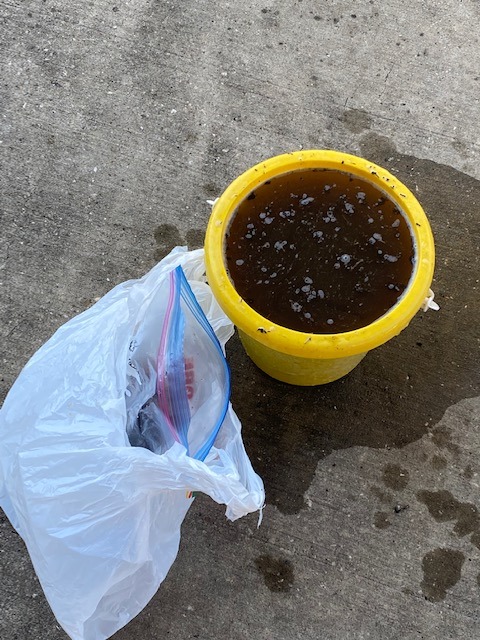
This was my set up, I used my backyard patio to do this.

This is the fabric in the solution. I am planning to keep this in for a total of 3 hours, but will go out and mix the solution and fabric so that all of the fabric will be in contact with the poop.
Later on Wednesday 11/23
I ended up letting the fabric soak in the solution for almost 5 hours. Then, I washed it off and hung it to dry.
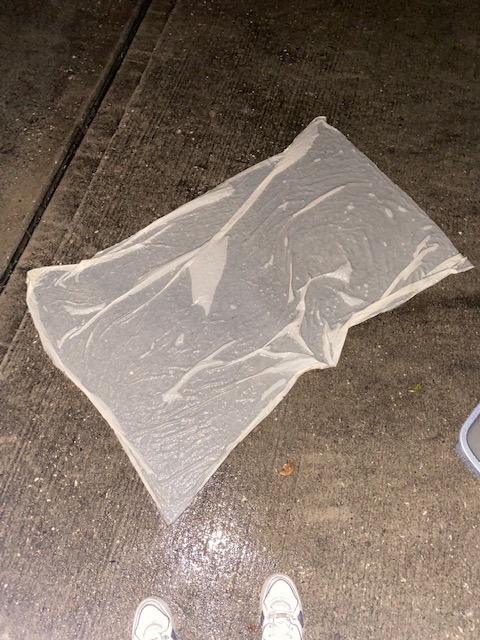
Here, I washed the fabric on my driveway. I'm glad I had the space that I did to be able to efficiently complete all of the required steps. It was dark by the time I was able to do the washing and rinsing. The cow poop still did not smell at all.

I hung the fabric to dry in my backyard over night. This is a broken swing frame that we have and hang stuff out on, so it really came in handy for this project. I used two clip hangers to put it up.
Friday 11/25
I did not get to do any work on Thanksgiving since we were out of the house all day for the holiday. It also rained a lot so it would not have been a productive day anyways in terms of working on this fabric.
However, the fabric was dry, so today I took a sturdy tooth brush to remove all of the debris from the fabric that remained from the cow poop mixture.
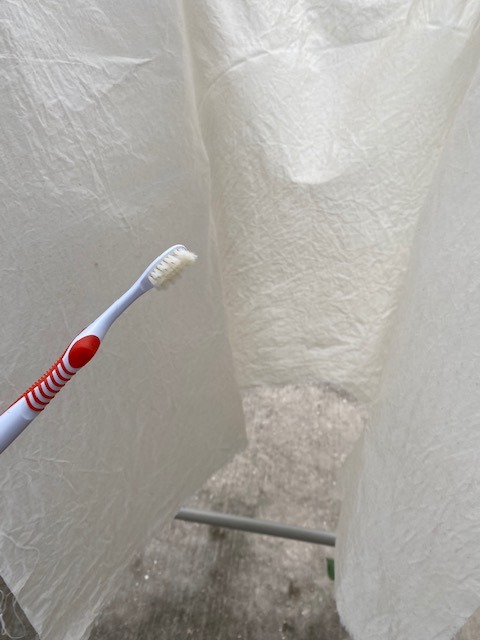
Then I prepared the buffalo milk soak. Apparently the fabric only needs to sit in the milk for 10 minutes, but I think I will leave it in longer to ensure that the fabric is prepared for "direct application" with natural dyes.
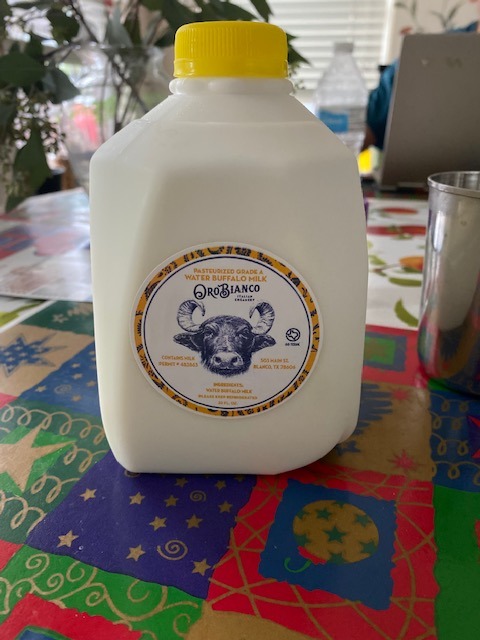
This is the buffalo milk that I got, it was 32 ounces, so the bottle was fairly small. It was in the same shape as a traditional gallon of milk, but since this was not a gallon, it looked so small and cute. My mom is saving the bottle because she likes it so much. I did the math and 32 ounces is 1/4 of a gallon. The brand is Oro Bianco, and I believe it is an Italian brand, the name translates to white gold in English.
I went out to pour it into the bin to soak within the fabric. However, I noticed there was a thick layer at the top, preventing the liquid part of the milk from coming out, almost like a stopper. I figured since we put it in the back of the fridge for a couple days, it had solidified too much, but when I brought it into the house my mom explained to me that it is actually cream that was sitting on top of the milk. Apparently buffalo milk has a higher fat content and this is why it had such rich cream on top. My mom, my dad, and I all tried the cream and it was good. Both of my parents said it reminded them of the dairy products they used to eat when they lived in India.

My mom used a chopstick to pull out some of the cream, as shown in the photo above. It was so thick that it was not really dripping down the chopstick, but staying in the same location on the stick.

This is the milk bath. After my mom removed the thick cream, I poured the actual milk part into a container.

This is a close up of the milk. It was very thick and bubbly. Not much of a smell really, but the after taste was a bit odd to me. It was not bad, but since cow milk does not have an aftertaste, I was not expecting this. The initial taste is very nice though, very rich and creamy.

Due to the thickness of the milk and the largeness of the fabric, I decided to add some water just to get the remainder out of the bottle, but also to ensure that the fabric will be properly saturated.
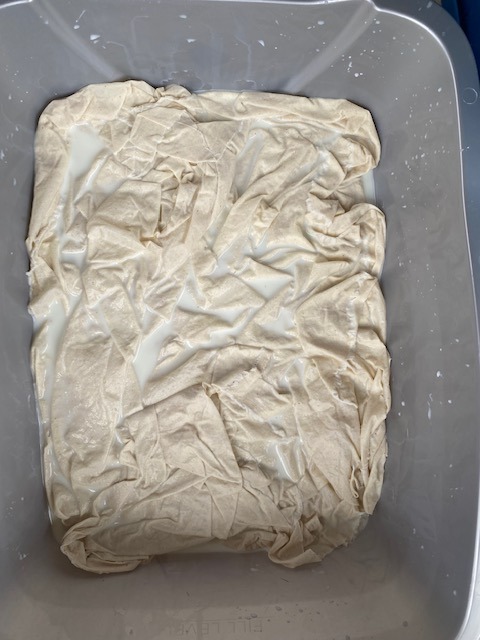
Then, I submerged the fabric into the milk. I will go out and flip the fabric over so there is maximum coverage. Also, the milk does not need to be rinsed off, it needs to remain as a layer on the fabric to mitigate potentially bleeding of the dye.
Since it was just milk, I did not use any gloves and I just put the fabric in with my hands. Therefore, the milk got on my hands, but when I rinsed it off with water, I noticed a waxy residue remained on my hands. It felt nice, like a moisturizer.
I also noted a scent. I was surprised in my research to find that people were using myrobalan seeds in the fabric processing to remove the scent from the fabric caused by the buffalo milk. Well, I sniffed it and the scent is a very mellow cream scent. It is very neutral, not good or bad, so I did not feel the need to remove the scent. Part of my surprise was due to the fact that no source says anything about the cow poop smelling at all, I guess I assumed it would and that it was obvious so it was not mentioned, but in reality there was no smell and I was very close to it and I did intentionally sniff it and still there was no smell. However, the buffalo milk smell was mentioned and it in fact did have a smell.
After it is taken out of the solution, I will hang it up to dry fully. Since I have to return to Waco on Saturday, I have to bring the natural dye colors with me to do in the studio. Hopefully I am not behind.
Saturday 11/26
My mom had all of the natural dyes that are usually used in traditional kalamkari: turmeric, tamarind, chili powder, Indian goose berry, Indian black plum, and cranberries. Some of these may not be used by people who actually do kalamkari, like the black plum or cranberries, but I am counting these as traditional materials since anything that is natural and gives a substantial color is used. The Indian goose berry serves as a natural mordant, as does alum, so I got both. A mordant stabilizes the natural dyes, which by nature can be unstable, thus allowing for the natural dye to last longer on the fabric.
I will have to bring the dried buffalo milk fabric back to Waco with me since I am leaving today so I can work on Sunday morning.
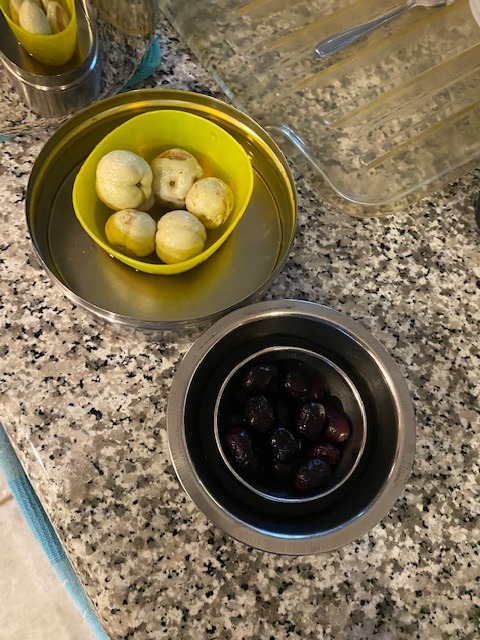
These are the Indian goose berry (Mildly green ones) and the plum colored ones are Indian black plum. The black plum was a surprise that my mom kept for me when I told her I was doing this project.
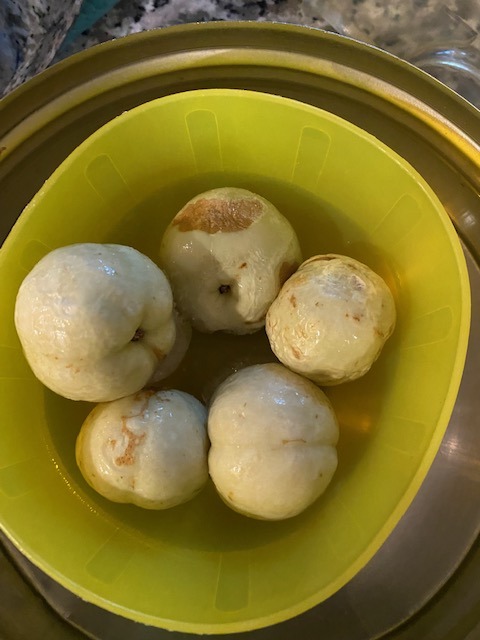
Close up of Indian goose berry.

Close up of Indian Black plum. This gives a nice rich purple color, so I am excited to see how it interacts with the fabric.

This is the Indian goose berry that my mom made into a paste, this will make it easier to use as a mordant.
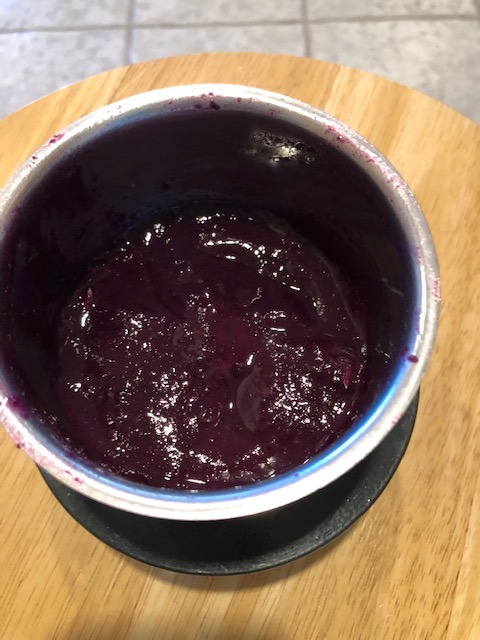
This is the paste form of the Indian black plum, this form makes it easier to paint onto the fabric.
Later in the day Update: I am back in Waco now and I am storing these in the fridge so they do not go bad. My mom put them in jars for me so I can limit the oxidation. I am so glad she helped me, I probably would have figured it out, but definitely not as quick or effectively.
Sunday 11/27/22
Today I realized that I am very bad at managing time. I know that many people suffer from this, but due to my severe ADHD, I experience something called "time blindness", in which I experience an inability to sense the passing of time. I believe that this also applies to my art, where I will take on very detailed and time consuming tasks, but during the planning process I significantly minimize the amount of time a task will take, thus resulting in a last minute stressful scramble. What a fun life. However, this time I have tried to combat this by planning ahead and working over the break. I am writing my intentions here, so then I can go back and see if I was able to combat this issue or not. I have also decided that the spaceship that will be taking away the uterus will be all black, like a darkness stealing the rights of women everywhere. It serves as a metaphor for a dark force taking our rights, but it also does not give any one person or institution particular blame for this issue, but rather leaves it up to the interpretation of the viewer. Who specifically is taking away these rights? In my personal opinion it is the fault of institutions and systems built based on the thoughts and principles that cater to the needs of men alone, while neglecting women.
Tuesday 11/29/22
This morning I planned on further preparing my fabric by applying mordants. Mordants, in the world of natural dyes, are used to stabilize natural dyes to achieve longer lasting and vivid colors. Without mordants, natural colors are unstable and therefore produce lighter colors that are prone to fading. For my mordants, I had Indian gooseberry, gifted to me by my mom who blended it up for me, and alum. Since I had two options and my research concluded in conflicting information, I decided to mix the alum, gooseberry, and some warm water together for a fun and exciting mixture. I came to this decision based on questionable serious of very logical thoughts. By this I mean, when I tried to do them separately the alum and water mix was very grainy and the gooseberry and water mix had a texture similar to applesauce. This led me to the choice of mixing them all together and interestingly enough it seemed to work the best in terms of spreadability. Then, I let the intrusive thoughts win and further spread the mixture with my hands, not sure why, but it felt right. The mordant needs to sit on the fabric for 24 hours to dry and set in. Tomorrow, I plan on coming in after my morning shift at work to start putting the dyes on the fabric.

This was my set up for today.

On the left is the gooseberry and water mixture and on the right, is the alum and water mixture.

This is what the fabric looks like with the mordant applied.
I wanted to add that a few days after the buffalo milk soak, the fabric had a pleasant sweet cream smell!
Wednesday 11/30 @7:49 pm
I came into the studio tonight to see if the mordant mixture was dried and to start on the next steps of my project. I noticed that there was a weird crusting happening. I think it was the alum. It was very resistant to mixing into the water, insoluble I dare say. I then had to tediously scrape off the crust from the surface of the fabric.
After the crust was removed, I made a mixture with turmeric and water for the back ground of my fabric. I picked this because I feel like the bright yellow will be able to give a weird, eerie feel. I worked on this until 11 pm. RIP my sanity. I stayed long because I was making good progress and I did not want to stop or interrupt the process while my focus was still there. I also decided that the beads as eggs on the overies of the uterus I made was too much and not reasonable. I decided sequins might work better since they cover greater area, but this will still emphasize the eggs within the ovaries. The egg emphasis is important to me, it highlights that a woman can still choose to conceive whenever she wants (assuming no other fertility issues) even after getting an abortion. That forcing someone to carry a child that they may not be able to physically, financially, or emotionally take care of is more detrimental than letting a woman choose to have a child when she is good and ready.
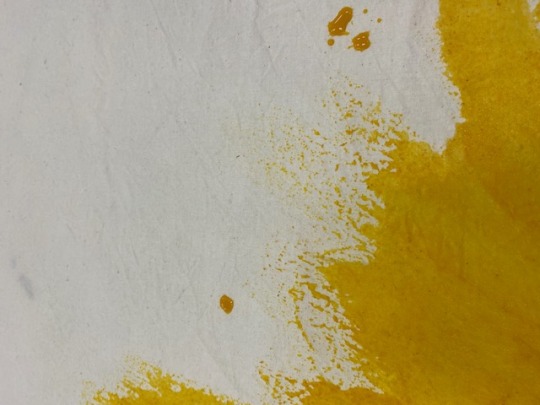
As I was painting the background, I noticed the drops of color beading on the fabric rather than absorbing in immediately.
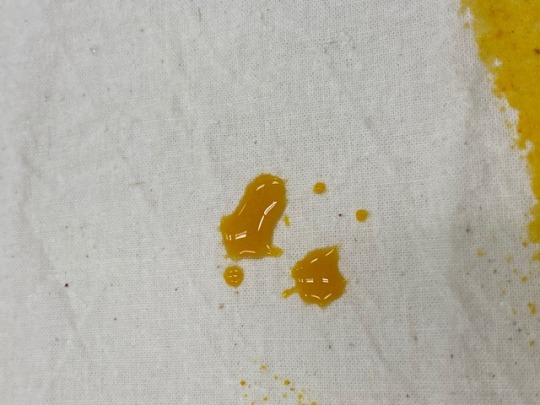
This is an up close beading. This post is crazy long, so I will make a different post explaining this phenomenon.

Thursday 12/1
Today I woke up struggling. Wednesday was a very tough day for me and my brain and body needed to recover. I decided it would be best for my health to rest a bit more. Eventually I made it to class and made some more progress, this time on the planet since the background was finished last night. I am using sindoor aka vermilion that is used in Hindu prayer rituals to try and achieve a bright red colorful planet in addition to Indian black plum. I also need to mix tamarind for a brown color and boil cranberries for another shade of red. The sindoor comes in multiple shades of red, so I have a true bright red, maroon, and orange. I hope these colors take to the fabric.

Today's planetary progress. I am a bit worried by the colors, they might be faded by the time I wash the fabric, but I hope not.
My goal is to finish up the planet painting, so that the colors can sit on the fabric for as long as possible to get it as bright as possible. Meanwhile, I will finish up the tree and uterus.
Friday 12/2
I continue to work on the planet.
Saturday 12/3
I have, as previously mentioned decided to change the beads on the ovaries to sequins. I felt that the beads gave a more clinical look, like it was a very apt way of showing the eggs, but I don't want this element to be solely clinical because it goes beyond that. By taking away the beads and replacing it with sequins, I am still able to emphasize the importance of the eggs within the ovaries, but in a more meaningful way.
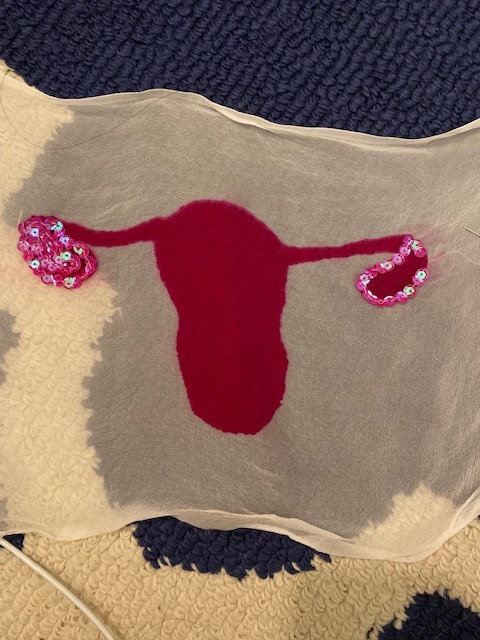
I am almost done with this part of the project. I am going to leave the body of the uterus plain like this, as adding details would give it a more clinical look rather than serving a symbolic purpose. It was hard to make this choice as I liked the way the beads looked, but upon review, the realistic nature of the ovaries, in my opinion, would take away from the meaning of my piece. By this, I mean that reproductive rights, since being politicized, now go beyond a clinical setting, they play an integral role in reproductive justice. My work attempts to discuss this issue through symbolic social commentary.
Sunday 12/4
Things are getting crazy this week. Everything is happening all at once, but I continue to work on my project whenever I can. I plan to wash my fabric on Monday evening, let it dry (while it dries I will finish up the space ship/ dark force), and then applique the tree on and attach the uterus and dark spaceship. The turmeric has sat on the fabric for the longest so I am hoping for a bright yellow to achieve an eerie background feel and establish a contrast with the dark force spaceship.
So tumblr has a limit of 30 pictures only per post and I have reached the limit, so I will create a journal part two to continue the documentation with photos.
0 notes
Text
Kinbands of the Farlands
The Searbond - Sanctum of Fire
An impressively long-standing kinband founded off of loners and house cats together. Once merely a small collection of cats just trying to survive, once charmers worked out how to create temporary wards, all the nearby loners and especially those with young kits quickly joined them.
Since the charmers spent most of their time defending and replacing the wards, it fell on non-charmers to feed them and find a way to keep the faction long-term. A solution was found in the form of textile designs - quickly they learned how to dye clothes and bandages, resist dying methods and became popular in the area as they were responsible for most of the Farlands’ braided chains and the blankets they made were usually for nurseries. Though they aren't quite an empire, their kinband is very popular on The Stretch for their latest projects after they started weaving runes and long-term enchantments into their larger creations.
Sear was the first cat to make contact with the Braalah - small fire based summons. Realizing how useful it could be, Sear went through the agonizing process of gaining a summon. He used it to defend their kinbond and the Braalah taught him better fire-based charming. When Sear had kits, three of the four were charmers and all of them were fire-based. After the death of his youngest, a series of rules were set in place for learning to summon and mastering fire-charming that has persisted to the present.
A devastating wave of Farcreatures overwhelmed the guard charmers and the kinband has scattered. In its wake were the kits of Tanager, the present head of the Searbond who the kinband hope will return to rebuild.
Mahir: Tanager (deceased), Myna (stand-in)
Charm Captain: Tumeric
Status: Disbanded
Summon Clan: Braalah
Most Common Charmer: Fire
Least Common Charmer: Water
Known Members: Rusty, Myna, Kite, Suna, Swallowtail, Flash, Twinkle, Sky, Fawn (suspected)
#projects by ankh#the farlands#the farlands au#the farlands worldbuilding#worldbuilding#warriors au#warriors#the warrior cats au#warrior cat ideas#warrior cats#warrior cat au#kinbands#the searbond kinband
1 note
·
View note
Text


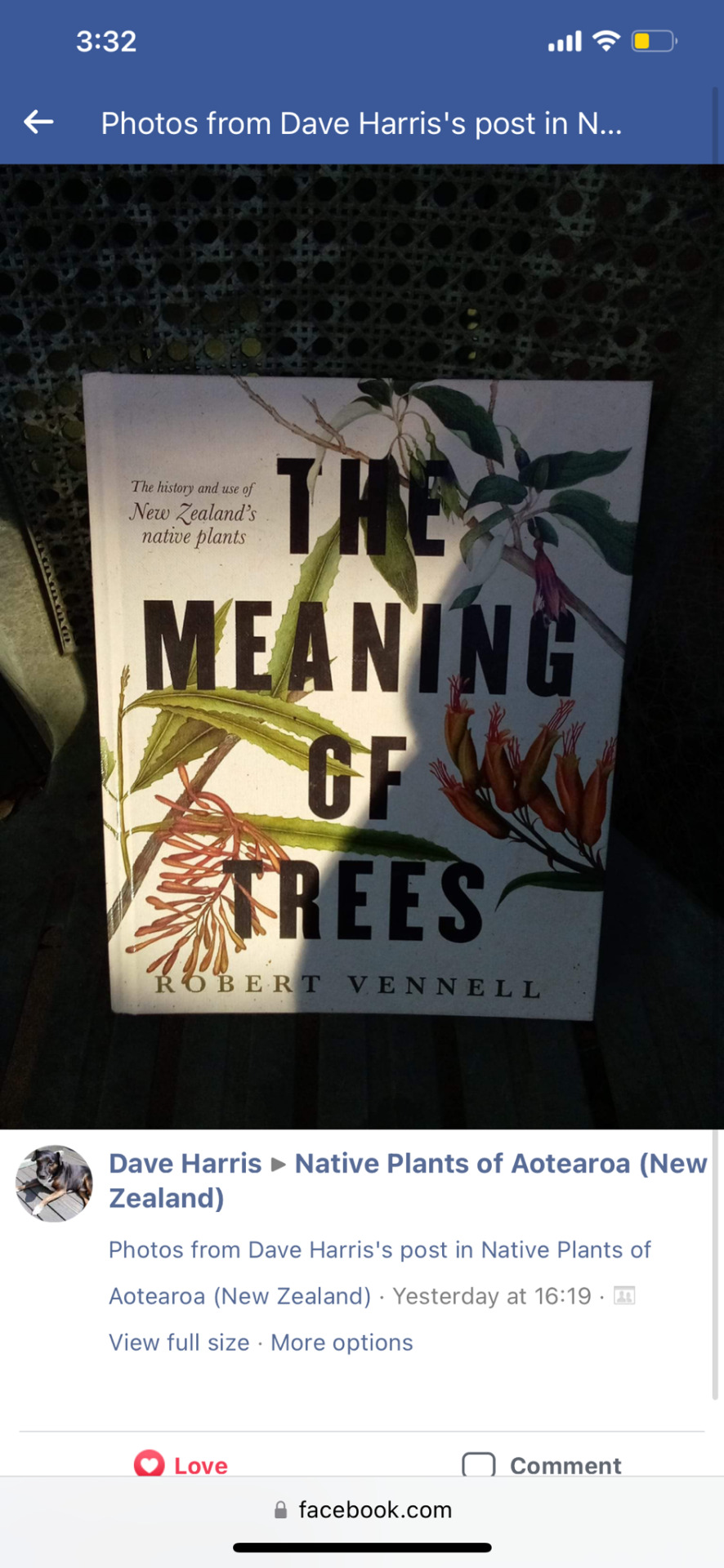
In the water mix is a dye made of non native acorns, and desidious seedlings as well as native Manuka flower seeds
Pakeha craft
The rag or wash cloth is made out of store bought wool chemically dyed, twine that typically makes nets, mohair wool that’s loose and naturally dyed with flax seed pods, and two other strands of NZ Wool dyed with nana tree flower and tumeric
0 notes
Text
Dying with Turmeric.
If someone has done so, please help me. I would like to try dying a piece of 100% cotton with tumeric, but I lack Vinegar and I have little interest in purchasing it because I never use it. The smell alone is also off putting and I don't want my grandmothers small apartment reeking of it.
I DO have left over Soda Ash mixture from my previous tie dye attempts, but I wanted to give this a try since I want to try a no cost tie dye.
So my question is: Is Vineger a necessary ingredient, or can I soak my cotton piece in the soda ash first, then use the turmeric to dye it.
1 note
·
View note
Photo

project.pico
Today’s dyeing vats full of turmeric, soap nuts and ash ready for lots of natural fibres and textiles to be submerged, heated, soaked and stirred until they turned different shades of sunshine yellow. Amazing to see the rainbow of colours that nature can produce and hear about the healing power of Ayurvedic ingredients
@ayurvastra.balaramapuram.9
in Tamil Nadu, India.
1 note
·
View note
Text
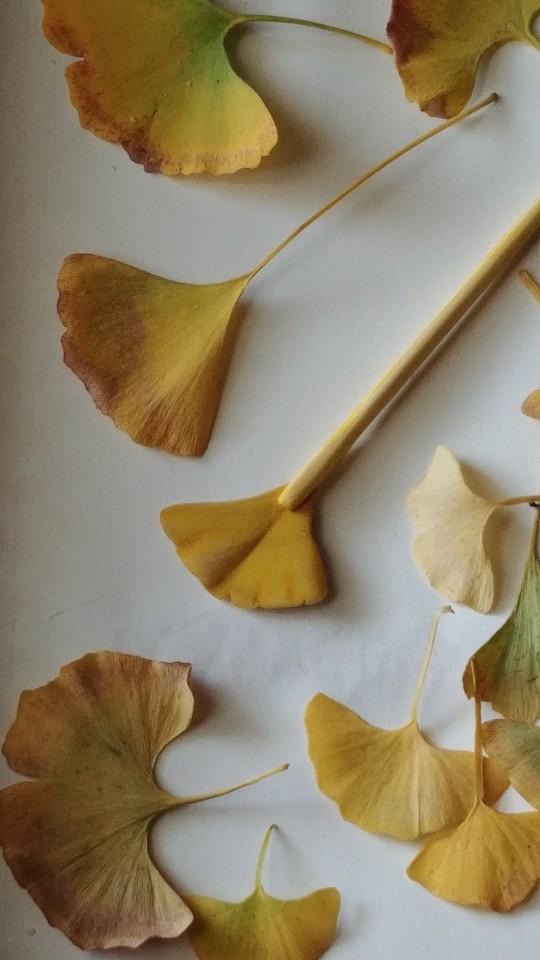
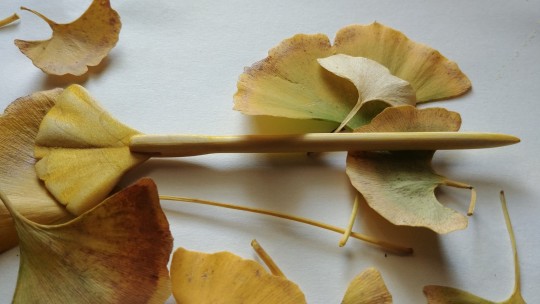


Hair stick shaped like a ginko leaf, dyed with tumeric and yellow onion skin.

#hair stick#hair sticks#ginko#gingkoleaf#leaf#autumn#handmade#woodworking#tumeric#wooden#carved#wip#natural dye#dyed#cottagecore#Art#artists on tumblr#crafts
43 notes
·
View notes